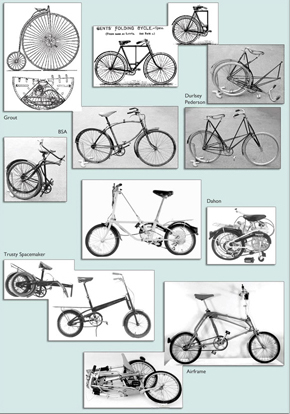6.3 Prototyping and improving
In Ritchie's first prototype design (P1) the rear wheel hinged forward in its own plane from the lowest point of its triangular support structure, as in the production model in Figure 46. However, unlike the production model, the front wheel of P1 also moved (almost) in its own plane underneath the bicycle to sit alongside its partner; in this case some sideways movement was needed to ensure that the front wheel sat next to the rear one, rather than just bumping against it as it hinged. To achieve this the front wheel needed a complex, skewed hinge to move it the few inches sideways so as to clear the rear wheel and chainwheel.
As well as moving the two wheels to the centre, it was necessary to move the saddle, together with its pillar, and the handlebars into the same space. The seat pillar telescoped to get the saddle into the packing space, which had the advantage that saddle height adjustment and packing were accomplished by the same mechanism. The telescoped seat pillar slid down behind the hinged rear wheel, so locking it in place, an important feature that has survived the transition from prototype to production.
Ritchie was driven by a search for 'the ultimate in compactness' when designing and building P1, which was a platform for various design ideas.
The chainwheel and the saddle competed for space in the folded package, so Ritchie tried to move the chainwheel away from where the saddle needed to be, but
…it was too complicated, I gave up an inch when that idea was dropped.
Ritchie (1999)
Prototype P1 used 18 inch wheels, then common on children's bicycles. The main tube of the frame was lower than in the production model and the bicycle was not stiff enough (see Stiffness and flexing). Bowden cables linked the front- and rear-wheel folding mechanisms.
Ritchie is a regular bicycle commuter in London, so he tests designs and design changes routinely and expertly. He was pleased with the realisation of the basic design concept in the first prototype:
I had demonstrated that the design concept could result in a compact folding bicycle.'
Ritchie (1999)
Ritchie uses the expression 'good luck rather than design' to describe unpredicted advantages of his conceptual design solution.
Stiffness and flexing
Try thinking of an example such as a badly sagging bookshelf. The problem with the shelf is that it was not stiff enough: it was deflecting too much under the load applied to it. The stiffer an object is, the less deflection there is when a force is applied to it.
To some degree, the amount of deflection depends on the shape and size of the objects carrying the load. Thus one solution to the problem of the sagging bookshelf is to use a thicker shelf. Greater thickness gives more stiffness.
An alternative is to change to a material which is inherently stiffer. The material's property related to stiffness is called the Young's modulus. Two components with identical dimensions will show different stiffnesses if they are made from steel and aluminium, say. The Young's modulus of steel is about three times that of aluminium, so it will make a stiffer component. (A formal definition of Young's modulus will be given shortly.)
SAQ 14
To make the frame of a bicycle light, hollow tubes are used. These are not as stiff as solid tubes. Suggest two ways in which hollow tubes might be made stiffer.
Answer
Two ways of changing the stiffness would be:
Use a stiffer material.
Make the tube thicker. This could be done by making the wall of the tube thicker, or by increasing the diameter of the tube. Both methods would increase the stiffness.

